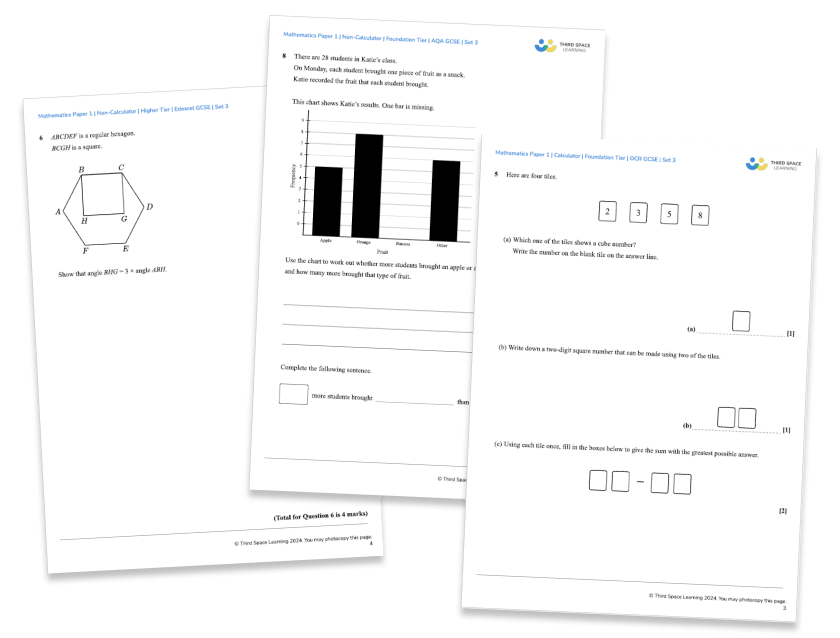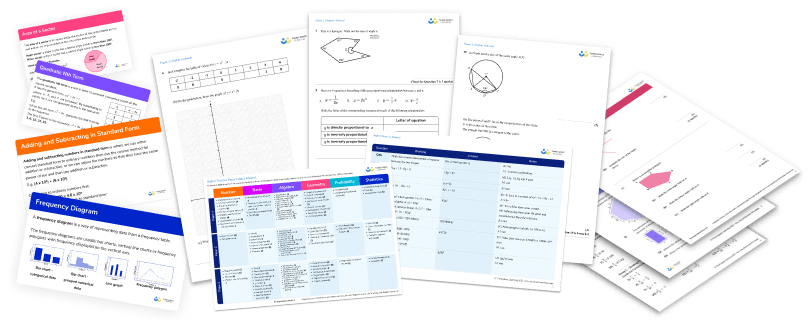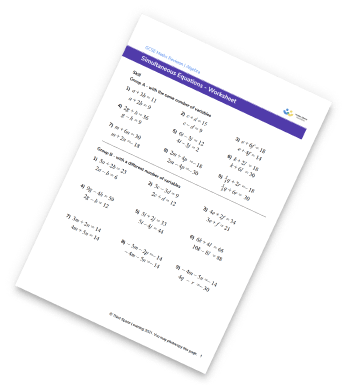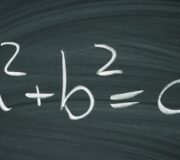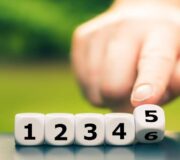15 Simultaneous Equations Questions And Practice Problems (KS3 & KS4): Harder GCSE Exam Style Questions Included
Simultaneous equations questions involve systems of equations in which there are two or more unknowns. When solving simultaneous equations, we are finding solutions which work for all of the equations in the system. Simultaneous equations can be solved graphically or algebraically.
Here, you will find a selection of simultaneous equations questions of varying difficulty, from questions suitable for KS3 students through to some tricky GCSE-style exam questions! The focus will be on word problems and problem solving questions.
GCSE MATHS 2026: STAY UP TO DATE
Join our email list to stay up to date with the latest news, revision lists and resources for GCSE maths 2026. We’re analysing each paper during the course of the 2026 GCSEs in order to identify the key topic areas to focus on for your revision.
GCSE dates 2026
GCSE results (2026 when available)
Get ahead on revision with the GCSE maths papers analysis from 2025:
Analysis of GCSE Maths Paper 1 2025
Analysis of GCSE Maths Paper 2 2025
GCSE Maths Paper Analysis and Summary 2025
GCSE Maths Teacher Survey Results 2025
How to solve simultaneous equations
In KS3 and KS4, we work with systems with two equations and two unknowns. There are three methods for solving simultaneous equations: graphically, by elimination or by substitution.
Solving simultaneous equations graphically
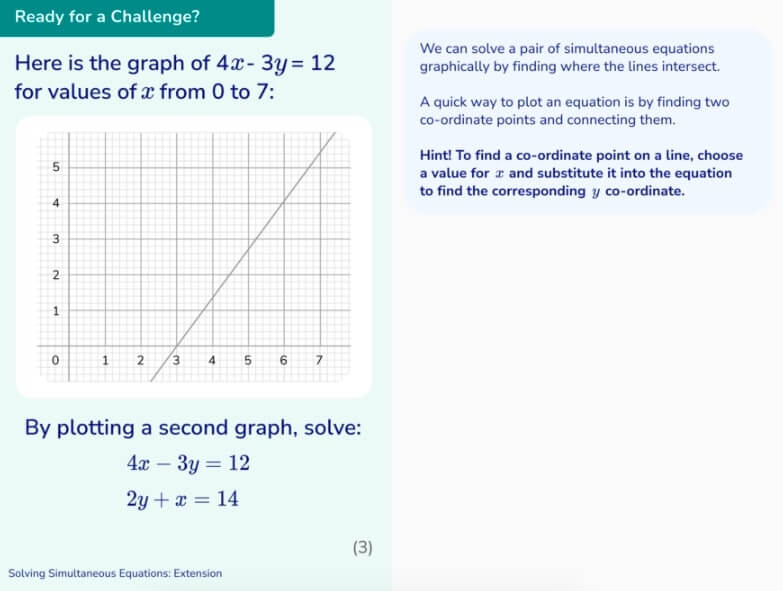
If we have two simultaneous equations, we can solve them by plotting their graphs. Once plotted, the solution or solutions will be the point or points of intersection of the two lines.
15 Simultaneous Equations Questions And Practice Problems (KS3 & KS4) Worksheet
Download this free worksheet on simultaneous equations. This set of 15 simultaneous equations questions and answer key will help you prepare for GCSE Maths
Download Free Now!Solving simultaneous equations by elimination
When solving simultaneous equations algebraically, elimination is a great method to use if we have two linear equations. Elimination works by making the coefficient of one of the variables the same in each equation and then subtracting one equation from the other to eliminate that variable.
For example, let’s solve the simultaneous equations
\begin{aligned} 3a + 2b = 19\\ 4a + 3b = 27\end{aligned}Step 1: Use multiplication to make the coefficient of one of the variables the same in both equations.
Multiplying the first equation by 3, we get 9a+6b=57.
Multiplying the second equation by 2, we get 8a+6b=54.
The coefficient of b for both equations is now 6.
Step 2: Subtract one equation from the other.
\begin{aligned} 9a + 6b = 57\\ -8a + 6b = 54\\ a = 3\end{aligned}Step 3: Substitute into one of the original equations to work out the other value.
\begin{aligned} 3a + 2b = 19\\ 3 \times 3 + 2b = 19\\ 9 + 2b = 19\\ 2b = 10\\ b = 5\end{aligned}Step 4: Check your answer by substituting both values into the other original equation.
\begin{aligned} 4a + 3b = 27\\ 4\times 3 + 3 \times 5 = 12 + 15 = 27\end{aligned}This works, so our solution is correct.
a=3 and b=5
Solving simultaneous equations by substitution
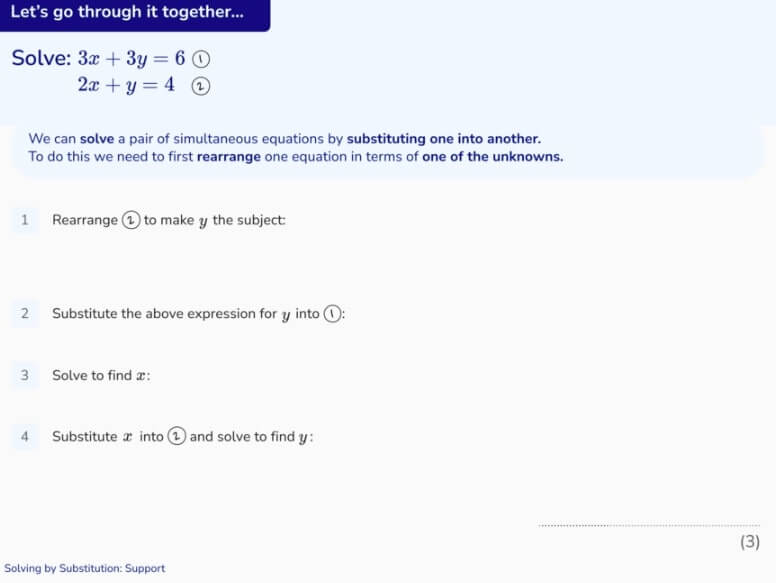
Substitution is a useful method to use when one or more of the equations is not linear. Substitution works by making one of the variables the subject of one of the equations and then substituting this into the other equation.
For example, let’s solve the simultaneous equations
\begin{aligned} 3x - y - 10 = 0\\ x^{2} + y^{2} = 100\end{aligned}Step 1: Make one of the variables the subject of one of the equations.
3x-y-10=0Rearranging this we get
y=3x-10Step 2: Substitute this into the other equation.
\begin{aligned} x^{2} + y^{2} = 100\\ x^{2} + (3x - 10)^{2} = 100\\ x^{2} + 9x^{2} - 60x + 100 = 100\\ 10x^{2} - 60x + 100 = 100\end{aligned}Step 3: Solve the equation.
\begin{aligned} 10x^{2} - 60x + 100 = 100\\ 10x^{2} - 60x = 0\\ x^{2} - 6x = 0\\ x(x - 6) = 0\end{aligned}x=0 or x=6
Step 4: Substitute into one of the original equations to find the other value.
y=3x-10When x=0
y=3\times0-10=-10When x=6
y=3\times6-10=8The solutions are x=0 and y=-10 or x=6 and y=8 .
Step 5: Check your answer by substituting into the other original equation.
x^{2}+y^{2}=100 0^{2}+(-10)^{2}=0+100=100or
6^{2}+8^{2}=36+64=100These both equal 100 , so our solutions are correct.
KS3 simultaneous equations questions
Simultaneous equations will first be covered towards the end of KS3. To begin with, students are taught how to solve simultaneous equations graphically and are introduced to the method of elimination.
Solving simultaneous equations questions graphically
1. The following graph shows the straight lines x+y=4 and y=2x-5.
Use the graph to find the coordinates of the point which satisfies both of the equations
\begin{aligned} \\ &x+y=4 \\ &y=2x-5 \end{aligned}




The equations have been plotted on the graph.
The solution to the simultaneous equations is the point at which the lines meet: x = 3, \ y = 1.
2. The following graph shows the line y=0.5x+3.
Use the graph to solve the simultaneous equations
\begin{aligned} \\ &y=0.5x+3 \\ &y = 4 \end{aligned}




We can plot the line y=4
Then the solution to the simultaneous equations is the point of intersection of the two lines: x=2, \ y=4.
Linear simultaneous equations
3. The difference between two numbers, m and n , is 6 . The sum of the two numbers is 22. For their difference, we can write the equation
m-n=6
Write an equation for their sum.
Solve the pair of simultaneous equations to find the values of m and n.




For the sum, the equation is m+n=22.
We can solve these equations by elimination.
The coefficient of m is 1 in both equations.
Subtracting them we get
\begin{aligned}
m+n&=22\\
-~m-n&=6\\
\hline
2n&=16
\end{aligned}
Therefore n=16 \div 2=8
Substituting back into one of the original equations
m + n = 22
We can check our answer by substituting into the other equation
\begin{aligned}
&m-n=6 \\
&14-8=6
\end{aligned}
This works, so our answer is correct.
The two numbers are 14 and 8.
4. The cost of 2 apples and 3 bananas is 90p . The cost of 3 apples and 1 banana is 65p . Find the cost of 1 apple and 1 banana.




We can write two equations here
\begin{aligned}
&2a + 3b = 90\\
&3a + b = 65
\end{aligned}
We need to make the coefficients of either a or b the same.
Multiplying the second equation by 3 we get 9a + 3b = 195.
Subtracting one equation from the other
\begin{aligned} &9a+3b&=195\\ -~&2a+3b&=90\\ \hline &7a&=105 \end{aligned}
Therefore a=105\div7=15
Substituting into one of the original equations
\begin{aligned} 3a+b&=65\\ 3 \times 15+b&=65\\ 45+b&=65\\ b&=20 \end{aligned}
We can check by substituting into the other original equation
2a+3b=90
2 \times 15+3 \times 20=30+60=90
This works, so our solution is correct.
The cost of an apple is 15p and the cost of a banana is 20p. Therefore the cost of an apple and a banana is 35p.
KS4 simultaneous equations questions
Simultaneous equations are covered more extensively in GCSE maths.
During KS4, the method of elimination is revisited and solving equations graphically is extended to include solving pairs of simultaneous equations where one equation may be a quadratic equation or another non-linear equation such as the equation of a circle. The method of substitution is also introduced as a way of solving quadratic simultaneous equations algebraically.
Simultaneous equations is a part of the national curriculum and is examined by all exam boards including Edexcel, AQA and OCR. The questions included below are great practice for students working towards GCSEs and many are of a similar style to those found on past papers.
Simultaneous equations also feature at A Level, so it is important for those wanting to study maths at KS5 to be confident in each of the methods discussed here.
Solving simultaneous equations questions graphically
5. Lucy has £15 pocket money saved up. Lucy gets another £2 each week.
Plot a line on the axis below to show how Lucy’s money will increase over time.
Charlie has no money saved. Charlie gets £5 pocket money each week.
Plot a line showing Charlie’s money on the same set of axes.
Use your lines to determine how many weeks it will be until Lucy and Charlie have the same amount of money and the amount they will each have at that time.
8 weeks £40

3 weeks £21

5 weeks £20

5 weeks £25

The lines intersect at 5 weeks and £25.
Therefore, Lucy and Charlie will have the same amount of money in 5 weeks and they will both have £25.
6. The following diagram shows the line y=x^{2}-1.
On the same set of axes, draw the graph of y=3x-1.
Use your graph to find the two solutions to the simultaneous equations y=x^{2}-1 and y=3x-1.
x = 2 and y = 3 or x = -2 and y = 3

x = 0 and y = -1 or x = 3 and y = 8

x = 3 and y = 8

3 = 0 and y = 0 or y = 3 and y = 9

The points of intersection are (0, \ -1) and (3, 8) , so the solutions to the simultaneous equations are x = 0 and y =-1 or x = 3 and y = 8.
Linear simultaneous equations
7. Fiona has a box of chocolates containing 12 identical chocolates. The total weight of the box and the chocolates is 294g.
Fiona eats 7 of the chocolates and the total weight of the box and chocolates decreases to 210g . What is the weight of the box?




If we call the weight of the box B and the weight of each chocolate C, then we can write two equations:
\begin{aligned} &B + 12C = 294\\ &B + 5C = 210 \end{aligned}
We can solve these using the elimination method.
The coefficient of B is the same in both equations, so we can go ahead and subtract one from the other:
\begin{aligned} B+12&C&=294\\ -~B+5&C&=210\\ \hline 7&C&=84 \end{aligned}
Therefore C=84\div 7=12
Substituting this into one of the original equations
\begin{aligned}
B+5C&=210\\
B+5\times 12&=210\\
B+60&=210\\
B&=150
\end{aligned}
We can check this by substituting these values into the other original equation
B + 12C = 294
150+12 \times 12=150+144=294
This works, so our answer is correct.
The box weighs 150g and the chocolates weigh 12g each.
8. 600 tickets to a village fair were sold. Adult tickets were sold for £5 and child tickets were sold for £3.
A total of £2500 was made from ticket sales. Work out the number of adult tickets and the number of child tickets sold.
300 adult tickets, 200 child tickets

450 adult tickets, 150 child tickets

200 adult tickets, 500 child tickets

350 adult tickets, 250 child tickets

We can write two equations.
If we call the number of adult tickets A and the number of child tickets C then
\begin{aligned} &A + C = 600\\ &5A + 3C = 2500 \end{aligned}
We can solve these using the elimination method.
Multiplying the first equation by 3 we get 3A + 3C = 1800.
Subtracting one equation from the other
\begin{aligned} &5A+3C&=2500\\ -~&3A+3C&=1800\\ \hline &2A&=700 \end{aligned}
Therefore A=700 \div 2=350
Substituting this into one of the original equations
\begin{aligned}
A+C&=600\\
350+C&=600\\
C&=250
\end{aligned}
We can check our answer by substituting into the other original equation
5A + 3C = 2500
5 \times 350 + 3 \times 250 = 1750+750=2500
This works, so our answer is correct.
350 adult tickets and 250 child tickets were sold.
9. Write and solve two simultaneous equations based on the puzzle below. Use your solution to find the value of each symbol in the puzzle and hence find the missing total.




There is one row and one column containing only lightning and sun symbols.
From these we can write the following equations
\begin{aligned} &3L + S = 22\\ &2L + 2S = 24 \end{aligned}
We can solve these using the elimination method.
Multiplying the first equation by 2 gives us 6L + 2S = 44.
Subtracting one of these from the other
\begin{aligned} &6L+2S&=44\\ -~&2L+2S&=24\\ \hline &4L&=20 \end{aligned}
Therefore L=20\div 4=5
Substituting into one of the original equations
\begin{aligned}
3L+S&=22\\
3 \times 5 + S&=22\\
15+S&=22\\
S&=7
\end{aligned}
Using a different column: 2L+2M=28.
\begin{aligned} 2\times 5+2M&=28\\ 10+2M&=28\\ 2M&=18\\ M&=9 \end{aligned}
The lightning symbol is worth 5 , the sun symbol is worth 7 and the moon symbol is worth 9.
We can check this by trying different rows or columns.
The missing total is 5 + 7 + 9 + 9 = 30.
10. Find the perimeter of the following rectangle




Since it is a rectangle, we can write two equations
\begin{aligned} &2y + 1 = 2x – y\\ &2x + 2y = 5x – 3y \end{aligned}
We can solve these using the elimination method.
Firstly, rearranging each equation we get
\begin{aligned} &2x – 3y = 1\\ &3x – 5y = 0 \end{aligned}
Next, we multiply the first equation by 5 and the second equation by 3 to make the coefficients of y the same
\begin{aligned} &10x – 15y = 5\\ &9x – 15y = 0 \end{aligned}
Subtracting one from the other
\begin{aligned}
&10x-15y&=5\\
-~&9x-15y&=0\\
\hline
&x&=5
\end{aligned}
Substituting this into one of the original equations
\begin{aligned}
2x-3y&=1\\
2\times 5-3y&=1\\
10-3y&=1\\
3y&=9\\
y&=3
\end{aligned}
We can check our answer by substituting these values into the other original equation
3x-5y = 0
3\times 5-5\times 3=15-15=0
This works, so our solution is correct.
We can now calculate the length and width of the rectangle.
\begin{aligned} &\text{Length: } 2\times3+1=7\\ &\text{Width: }2 \times 5+2\times 3=16 \end{aligned}
Non-linear simultaneous equations questions
11. The area of a rectangle is 48cm^2 . The perimeter of the rectangle is 32cm . Write two equations using this information and solve them simultaneously to find the length and width of the rectangle.
Length 12cm , width 4cm

Length 24cm , width 2cm

Length 6cm , width 10cm

Length 8cm , width 6cm

If we call the length of the rectangle a and the width b then
\begin{aligned} &ab = 48\\ &2a + 2b = 32 \end{aligned}
We can solve these using the substitution method.
Firstly, we rearrange one equation to make one of the variables the subject
\begin{aligned} 2a+2b&=32\\ a+b&=16\\ a&=16-b \end{aligned}
Then we substitute this into the other equation
\begin{aligned} ab&=48\\ (16-b)b&=48\\ 16b-b^{2}&=48\\ b^{2}-16b+48&=0\\ (b-4)(b-12)&=0 \end{aligned}
b = 4 or b = 12
Substituting these back into one of the original equations
ab = 48
If b = 4, \ 4a = 48 so a = 12
If b = 12, \ 12a = 48 so a = 4
The side lengths are 4 and 12.
Checking this for the perimeter
2 \times 4 + 2 \times 12 = 8+24=32
This works, so our answer is correct
12. The sum of two numbers is 16. The difference between the squares of the two numbers is 32. Find the difference between the two numbers.




From this information we can write the equations
\begin{aligned} &a + b = 16\\ &a^{2}-b^{2} = 32 \end{aligned}
We can solve these using substitution.
First, make one of the variables the subject of one of the equations
\begin{aligned} a+b&=16\\ a&=16-b \end{aligned}
Next, substitute this into the other equation
\begin{aligned} a^{2}-b^{2}&=32\\ (16-b)^{2}-b^{2}&=32\\ 256-32b+b^{2}-b^{2}&=32\\ 256-32b&=32\\ 32b&=224\\ b&=7 \end{aligned}
Substituting this into one of the original equations
\begin{aligned} a+b&=16\\ a+7&=16\\ a&=9 \end{aligned}
We can check this by substituting into the other original equation
\begin{aligned} &a^{2}-b^{2} = 32\\\\ &9^{2}-7^{2} = 81-49 = 32 \end{aligned}
This works, so our solution is correct.
The difference between a and b is 9-7 = 2.
13. A circle has equation x^{2}+y^{2}=25 and a line has equation y=3x-5 . The circle and the line intersect at the points A and B. Find the coordinates of the points A and B.
(0, -5) and (3, 4)

(0, 5) and (3, 4)

(3, 4) and (10, 25)

(-3, -4) and (0, -5)

The coordinates of the points of intersection are the solutions to the simultaneous equations.
We can solve these using substitution.
We know that y = 3x-5, so substituting this into the other equation
\begin{aligned} x^{2}+y^{2}&=25\\ x^{2}+(3x-5)^{2}&=25\\ x^{2}+9x^{2}-30x+25&=25\\ 10x^{2}-30x&=0\\ 10x(x-3)&=0 \end{aligned}
x=0 or x=3
Substituting these values into one of the original equations
y = 3x-5
When x = 0
y=3\times 0 -5=-5
When x = 3
y=3\times 3-5=4
The points of intersection are (0, -5) and (3, 4).
We can check these values by substituting them into the equation for the circle
\begin{aligned} &x^{2}+y^{2}=25\\ &0^{2}+(-5)^{2}=0+25=25\\ &3^{2}+4^{2}=16+9=25 \end{aligned}
Both solutions work, so our answer is correct.
Hard GCSE simultaneous equations questions
14. The lines y=2x^{2}-13x+15 and x-y+3=0 intersect at the points P and Q. Find the length of the line PQ.




To find the points of intersection of the lines, we solve the equations simultaneously.
We can do this using substitution.
First, rearrange one equation so that one of the variables is the subject
\begin{aligned} x-y+3&=0\\ y&=x+3 \end{aligned}
Now, substitute into the other equation
\begin{aligned} x+3&=2x^{2}-13x+15\\ 2x^{2}-14x+12&=0\\ x^{2}-7x+6&=0\\ (x-1)(x-6)&=0 \end{aligned}
x=1 or x=6
Substituting these into one of the original equations
y=x+3
When x = 1, \ y = 4
When x = 6, \ y = 9
The points of intersection are (1, 4) and (6, 9).
To find the length of the line PQ, we use Pythagoras theorem
\begin{aligned} PQ^{2}&=(6-1)^{2}+(9-4)^{2}\\ PQ^{2}&=25+25\\ PQ^{2}&=50\\ PQ&=\sqrt{50}\\ PQ&=5 \sqrt{2} \end{aligned}
The length of the line is 5 \sqrt{2}
15. Solve the simultaneous equations
\begin{aligned} &3×2+2xy+y2=89 \\ &2x+y=11 \end{aligned}
x = 2 and y = 7 or x = 5 and y = 1

\frac{3}{2} and y = 8 or x = 2 and x = 7

x = 1 and y = 9 or x = 5 and y = 1

\frac{16}{3} and \frac{1}{3} or x = 2 and y = 7

This can be solved using substitution.
First, rearrange one equation so that one of the variables is the subject
y = 11-2x
Next, substitute this into the other equation
\begin{aligned} 3x^{2}+2xy+y^{2}&=89\\ 3x^{2}+2x(11-2x)+(11-2x)^{2}&=89\\ 3x^{2}+22x-4x^{2}+121-44x+4x^{2}&=89\\ 3x^{2}-22x+32&=0\\ (3x-16)(x-2)&=0 \end{aligned}
x=\frac{16}{3} or x=2
Substituting these into one of the original equations
2x+y=11
When x=\frac{16}{3}:
\begin{aligned} \\ 2 \times \frac{16}{3}+y&=11\\ y&=11-\frac{32}{3}\\ y&=\frac{1}{3} \end{aligned}
When x=2
\begin{aligned} \\ 2 \times 2+y&=11\\ y&=11-4\\ y&=7 \end{aligned}
The solutions are x=\frac{16}{3} and y=\frac{1}{3} or x=2 and y=7 .
We can check these solutions by substituting them back into the other original equation
3x^{2}+2xy+y{2}=89
\begin{aligned} 3 \times 2^{2}+2\times 2 \times 7 + 7^{2} &=89\\ 12+28+49&=89\\ 89&=89 \end{aligned}
\begin{aligned} 3 \times (\frac{16}{3})^{2}+2\times \frac{16}{13} \times \frac{1}{3} + (\frac{1}{3})^{2} &=89\\\\ \frac{768}{9}+\frac{32}{9}+\frac{1}{19}&=89\\\\ \frac{801}{9}&=89\\\\ 89&=89 \end{aligned}
Both solutions work, so our answers are correct.
More KS3 and KS4 maths questions:
DO YOU HAVE STUDENTS WHO NEED MORE SUPPORT IN MATHS?
Skye – our AI maths tutor built by teachers – gives students personalised one-to-one lessons that address learning gaps and build confidence.
Since 2013 we’ve taught over 2 million hours of maths lessons to more than 170,000 students to help them become fluent, able mathematicians.
Explore our AI maths tutoring or find out how our GCSE maths tutoring programmes could support students in your school.
